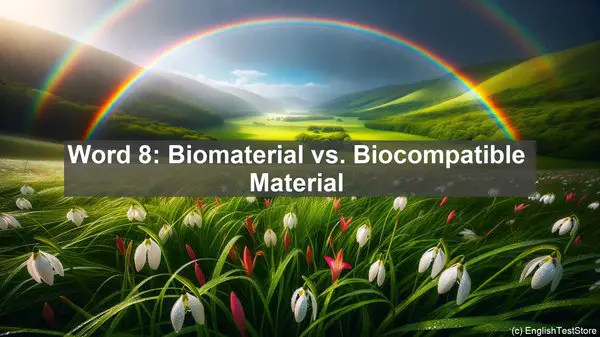Introduction to Biomimetics
Welcome to today’s lesson on biomimetics. Before we dive into the details, let’s quickly understand what biomimetics is all about. Biomimetics is a field that draws inspiration from nature’s designs and processes to solve human challenges. It’s a fascinating area that combines biology, engineering, and innovation.

Word 1: Biomimicry vs. Biomimetics
One of the most common confusions in biomimetics is the difference between biomimicry and biomimetics. While these terms are often used interchangeably, there is a subtle distinction. Biomimicry refers to imitating nature’s solutions, whereas biomimetics encompasses a broader range of activities, including understanding, analyzing, and applying nature’s principles.
Word 2: Bionics vs. Biomimetics
Another pair of words that often cause confusion is bionics and biomimetics. Bionics focuses on creating artificial systems that imitate natural ones, while biomimetics goes beyond imitation and aims to understand and apply nature’s principles. So, while bionics is a subset of biomimetics, the latter is a more comprehensive term.
Word 3: Analogous vs. Homologous
In the context of biomimetics, analogous and homologous are two terms that are frequently misused. Analogous refers to structures or functions that are similar in their purpose, but not necessarily in their origin. On the other hand, homologous refers to structures or functions that have a common evolutionary origin, even if they may have different purposes in different organisms.
Word 4: Bioinspiration vs. Biomimicry
Bioinspiration and biomimicry are often used interchangeably, but there is a subtle difference. Bioinspiration refers to the process of gaining ideas or insights from nature, while biomimicry is the application of those ideas to solve human challenges. So, bioinspiration is the first step, and biomimicry is the subsequent action.
Word 5: Convergent Evolution vs. Divergent Evolution
Convergent evolution and divergent evolution are two important concepts in biomimetics. Convergent evolution refers to the independent development of similar traits in unrelated organisms due to similar environmental pressures. Divergent evolution, on the other hand, is the opposite, where related organisms diverge and develop distinct traits over time.

Word 6: Morphology vs. Function
Morphology and function are two fundamental aspects in the study of biomimetics. Morphology refers to the form or structure of an organism or its parts, while function relates to the purpose or role of those structures. Understanding the relationship between morphology and function is crucial in biomimetics, as it helps in identifying and applying nature’s solutions effectively.
Word 7: Structural Color vs. Pigment Color
When it comes to color in nature, there are two types: structural color and pigment color. Structural color is the result of light interacting with nanostructures, giving rise to vibrant hues. Pigment color, on the other hand, is due to the presence of specific pigments that absorb and reflect certain wavelengths of light. Both types of color have their unique properties and applications in biomimetics.
Word 8: Biomaterial vs. Biocompatible Material
Biomaterial and biocompatible material are terms often used in the context of medical applications. Biomaterial refers to any material that is used in or interacts with living systems. Biocompatible material, on the other hand, specifically refers to materials that are well-tolerated by living tissues without causing adverse reactions. So, while all biocompatible materials are biomaterials, the reverse may not be true.
Word 9: Microscale vs. Nanoscale
In the world of biomimetics, scale is of utmost importance. Microscale refers to the realm of micrometers, which is a thousand times smaller than a millimeter. Nanoscale, on the other hand, is even smaller, measuring in nanometers. Many of nature’s intricate structures and processes occur at these tiny scales, and understanding them is crucial in biomimetic design.
Word 10: Adaptation vs. Innovation
The final pair of words we’ll discuss is adaptation and innovation. Adaptation refers to the process of organisms modifying themselves to fit their environment better. Innovation, on the other hand, is the human-driven process of creating something new or improving existing solutions. In biomimetics, we often combine the principles of adaptation and innovation to develop effective and sustainable solutions.
